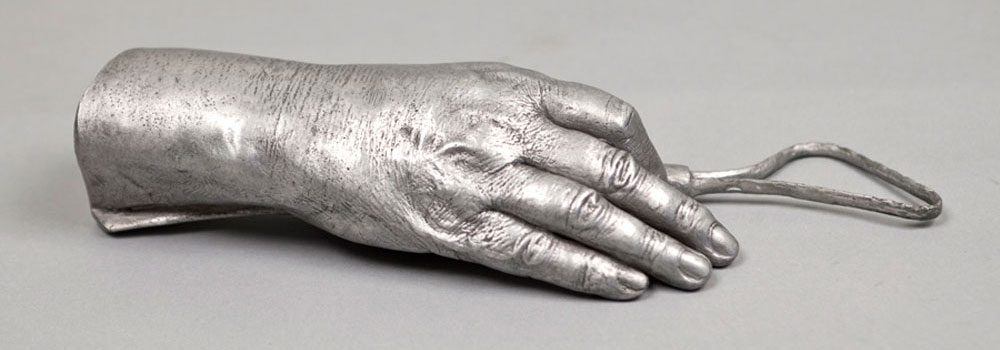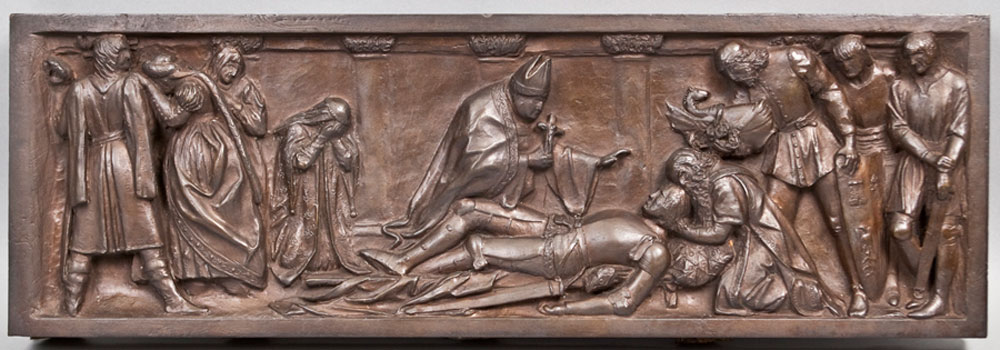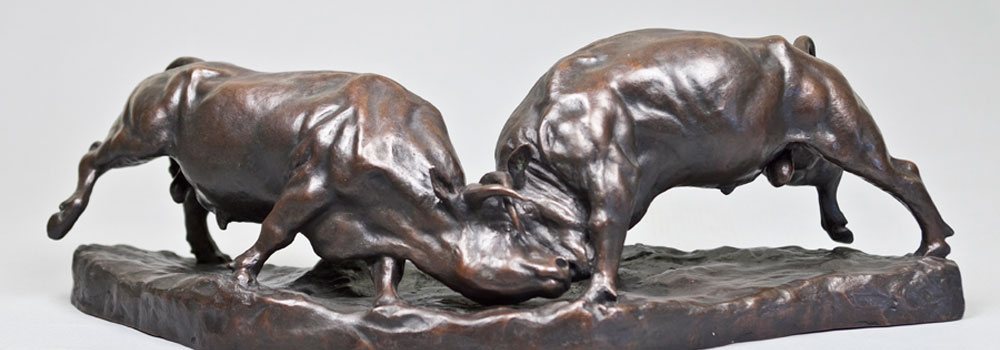Anna Hyatt Huntington and Her Big Cats
By Daria Rose Foner
Anna Hyatt Huntington loved big cats. Beginning with her first cat sculptures in 1898, she created hundreds of jaguars, leopards, lions, and tigers in all shapes and sizes.
[image: ahhuntington_8447.tif.jpg]
[caption: Anna Hyatt Huntington face to face with her sculpture, Jaguar. Still photo from 1930 film, Sculpture in Stone. Photo courtesy of Anna Hyatt Huntington Papers, Special Collections Research Center, Syracuse University Libraries.]
NOTE: this image is also in the Time Line and possibly Anne’s Essay though the one there may change.
AHH’s father, the zoologist and paleontologist Alpheus Hyatt (1838-1902), who worked at the Boston Society of Natural History from 1870 until his death in 1902, undoubtedly nurtured her love of animals. She recalled many years later: “I had a feeling for animals from the time I could crawl around.” She observed them carefully. On 26 April 1896, AHH wrote about an outing to the Maryland Zoo with her brother, William: “It is very wild and green, the majority of animals having a large yard to run in. They have about all the varieties of foxes and wolves and even the Eskimo dogs. We stayed to see the lions and tigers fed. Before they were fed, they roared and lashed up and down [in] their cages as if they were furiously hungry, but when they received their meat, they lost all appetite, only biting and licking it. One old fellow grabbed his share in his mouth and holding his very high, marched triumphantly around the cage as if he wanted to fool the spectators in the belief that he had caught it.”
During the 1890s, AHH began studying wild animals in earnest at Norumbega Park in Newton, Massachusetts, and Bostock’s Live Animal Show in Boston. She described how, at Bostock’s, “the animal trainer would let me stay right at the edge of the cage,” with tools in hand. She wrote about the delight of being in the company of animals as an “animalier” sculptor: “I have always thought the animalier had more fun in his work than artists in other branches, as he must be a real lover of animals to be able to interpret them—which means your work brings you in constant contact with material that delights you, making every moment a fascinating study. The only vexation is one has not fingers enough to catch in clay all that you see. What an advantage if an animal sculptor could possess the arms of Siva.”
In 1902, after settling in New York, AHH spent much time at the New York Zoological Society, today’s Bronx Zoo. There she modeled a variety of animals, from bison and bears to llamas and lions. She insisted throughout her career on the necessity of modeling animal subjects from life, rather than studying them in an academic setting. She explained, “I never studied with any one person. I worked on my own. I adored animals, so I studied in zoos. I spent years in zoos, especially the Bronx Zoo, just to study the animals.” Writers have long employed the trope of the naturally talented artist who from a young age demonstrated genius. Lorenzo Ghiberti framed Giotto Bondone this way, as Giorgio Vasari did Michelangelo. Then journalist Anna Coleman Ladd made this connection with legendary Italian artists explicit in 1912 when she wrote, “Anna Hyatt was little more than a baby when, like Giotto, she followed and drew the sheep on a farm, and knew by heart the points and names of a hundred thoroughbreds from pictures, before she had learned to read.” Although AHH was blessed with visual acuity, she studied, albeit briefly, with Henry Hudson Kitson in Boston and Hermon Atkins MacNeil and Gutzon Borglum at the Art Students League in New York.
[image: FonerEssay2.jpg]
[caption: Photograph of Anna Hyatt Huntington holding a clay model of a bear standing before a bear cage. Image from artist’s scrapbook, c. 1898-1907. Photo courtesy The Hispanic Society of America.]
During her period of most intense work at the New York Zoological Society, she and her mother boarded nearby in the Bronx. AHH recalled “doing a lot of wild animal studies in the studio provided for artists in the Lion building. We [the artists] had lockers there to keep our clay models so as not to have to carry them back and forth.” She continued: “I remember having one small model of a tiger completely crushed that I had just finished and was carrying home in a street car, it was resting on my lap when a large woman lost her balance by a jerk of the car when walking in the aisle and her hand came down on my model smack, the model was flattened and she shrieked thinking the model was alive.” AHH made rough sketches and miniature clay models while observing the animals first-hand. She worked small lumps of plasterline on modeling tablets, transforming clay masses into sketches of wild beasts.
By 1905, AHH had piqued the interest of a New York Times reporter, who described “a tall young woman in a gray tailor-made frock and a red-plumed hat.” The article imagines AHH speaking to her model, Bos the bison, as she sculpted. She related the trials and tribulations of working from life: “a relative of yours at Boston charged at me through the wire fence while my back was turned. His horn just touched my dress. Another time a lioness reached her paw through the bars, and failing her purpose, took consolation by smashing my model into bits. The cat family can’t be trusted. Sultan, the big lion up here, has been very friendly, but he is an exception that proves the rule. The worst experience was with an elephant who tried to kill me because he disapproved of my work. He slapped me sideways on the head, intending to step on my fallen body, but the force of the blow sent me ten feet away and out of further harm.”
[image: FonerEssay3.jpg]
[caption: New York Times article published 31 December 1905. Image from artist’s scrapbook, c. 1898-1907. Photo courtesy The Hispanic Society of America.
One ferocious animal, in particular, captured AHH’s attention: the celebrity Paraguayan jaguar Señor Lopez, who served as a source of inspiration over nearly four decades. A newspaper article relates the “unusual story” of AHH’s modeling of Señor Lopez for Reaching Jaguar at the Bronx Zoo. “This animal, a magnificent specimen owned by the Bronx Zoo, was so ferocious that even his keepers were unable to make friends with him. So violent was his temper that he killed a beautiful mate the instant she was admitted to his cage. It was the animal’s habit once or twice each day to climb upon a shelf-like ledge of rock within his enclosure, then, turning slowly, to begin the descent. Every day for two months Miss Hyatt sat before his cage, waiting with infinite patience for this moment when working rapidly she would model some muscle or portion of his lithe body in clay. As the days passed the animal began to show signs of wishing to make friends with this gentle voiced woman. Finally, to the chagrin and admiration of the keepers, at the end of two months the jaguar would lie close to the bars to be scratched, muttering friendly jungle talk the while.” As AHH’s sketchbook reveals, she often studied Señor Lopez, examining the curve of his backbone, his arched body, sinuous form, and intensity of facial expression. Such close and repeated inspection allowed her to convey the animal’s ferocity and feral athleticism, poised to attack at any instant.
[image: FonerEssay4.tiff]
[caption: 1906 postcard of Señor Lopez, the first inhabitant of the Bronx Zoo’s Lion House. Opened in January 1903, the building was the largest and most ornate in the complex at the time. Designed to provide the newest innovations in animal display, the light and airy space featured raised, well-marked cages with unobstructed views of the animals, as well as an artist’s studio. Photo courtesy the Wildlife Conservation Society Archives.]
[image: FonerEssay5.jpg]
[caption: Page from Anna Hyatt Huntington’s sketchbook. Rapidly sketched, this drawing captures the elongated jaguar’s silhouette and also includes a cursory study of the animal’s facial features. The artist’s use of minimal lines suggests the difficulty in using often-recalcitrant animals as models. Photo courtesy The Hispanic Society of America.]
[image: FonerEssay6.jpg]
[caption: Detail from the Anna Hyatt Huntington’s sketchbook. Anna Hyatt Huntington employed drawings for a variety of purposes in her creative process. She carefully renders the jaguar’s head, examining the animal’s features both in profile and straight on. Photo courtesy of The Hispanic Society of America.]
[image: FonerEssay7.jpg]
[caption: Detail from Anna Hyatt Huntington’s sketchbook. In this sketch, she seeks to capture the instant of a “leopard leaping for prey.” Photo courtesy The Hispanic Society of America.]
AHH employed Gorham Manufacturing Company, John Williams, Kunst Foundries, and Roman Bronze Works to cast her numerous works of lions, jaguars, and tigers. She fostered a particularly close relationship with Gorham, which held exhibitions at the Gorham Gallery as early as 1903 to promote her work. Beginning in 1906, Gorham cast at least nine big cat statuettes: Lioness and Cub (Q9, 84 casts), Jaguar Reaching (Q38, 251 casts), Tiger Group (Q229, 4 casts), Lion and Lioness Group (Q237, 19 casts), Jaguar Reaching (Q477, 16 casts), Tiger Yawning (Q492, 359 casts), Reaching Jaguar (Q493, 23 casts), Jaguar (Q494, 25 casts), and Yawning Tiger (Q509, 118 casts). In addition to making these 699 small-scale bronze statues, AHH also employed Gorham to make unique pieces on occasion, although the records for these prove more difficult to trace.
[image: SYRAG_Yawningtiger1.tiff]
[caption: Yawning Tiger, 1902-06; cast 1919-21. Bronze; 8 3/8 x 28 1/3 x 7 1/4 in. | 21.27 x 71.76 x 19.69 cm. Collection Syracuse University Art Galleries, gift of Linda Witherill (1993.039). Photo courtesy of Syracuse University Art Galleries.]
NOTE: THIS IMAGE IS ALSO USED IN CHECKLIST AND ANNE’S ESSAY
Through her ongoing relationship with the foundry, she exhibited her work frequently at the Gorham Gallery. In a review of a 1914 exhibition, the leading art critic Royal Cortissoz wrote about her animal subjects: “She has, to begin with, a really intimate knowledge of them. She knows not only their forms but their movements, the way they carry their heads, the way in which their feet grip the ground. There is something immediately convincing about these creatures of hers....This sculptor is, in a word, skillful, faithful and spirited.”
After forging her own “American” identity as an artist, AHH spent several years working in Europe. Before traveling, she claimed: “It is unnecessary for a sculptor to go abroad to study today. We have schools and masters in this country who can give much. Art centres that are really art centres of the serious kind have been formed in the last few years. The flighty student life has little place in the life of those who really wish to do something. There are museums here with fine examples of the antique. There is in fact, every facility for study. Why go abroad?” But, abroad she went in 1906.
She occupied the former studio in Auvers-sur-Oise near Paris of Charles-François Daubigny, a 19th-century landscape painter associated with the Barbizon school. (“Think of working in a studio permeated by the sprit of Daubigny!” Daniel Chester French wrote to AHH.) Here, she worked on monumentalizing her small models created at the New York Zoological Society. One visitor to her studio in 1907 reported: “Two life-sized jaguars, recently cast in plaster and designed for a gate entrance, meet the eye first, not so much because of their size as their virility. The muscles in the shoulder of the foreleg was a close subtle study and could only be obtained by patient waiting and the few instants that the creature could be made to hold that position by the threatening gestures of the keeper.” Jaguar and Reaching Jaguar were the first two life-size pieces that AHH created.
In the Paris Salons of 1908 and 1910, AHH exhibited two sculptures: Groupe de vatours and Jaguar. Ludovic Baschet lists both works in his illustrated catalogues of the two salons, however does not include images of either. Although Baschet lists the sculpture as Jaguar in both 1908 and 1910, it seems that AHH’s recently completed plaster cast of Reaching Jaguar was the work actually on display. During AHH’s second French sojourn in 1909, while working in a large, ground floor studio near the Gare Montparnasse, she wrote to her mother about a visit from the sculptor M. Deraux. “From the way he spoke he was evidently on the jury for the Salon as he remembered my jaguar which reaches down. They didn’t like the fact that the paw rested on a flat surface, but when I explained it was intended for a square pedistal [sic], he seemed to be satisfied.” From their inception, Jaguar and Reaching Jaguar received high praise. The sculptor and art writer Leonardo Taft lauded the “thrilling” pair—“in those reaching panthers you have done a supremely original work.”
Upon AHH’s return from Europe in 1910, at least one of her life-size sculptures was among the forty-three pieces included in a January 1914 exhibition at Gorham Gallery, Fifth Avenue at 36th Street, and later that decade, she lent the plaster model of Jaguar Reaching to the Metropolitan Museum of Art.
In 1921, when AHH first cast the plaster versions of Jaguar and Reaching Jaguar into bronze, she was at the height of her public acclaim and artistic success. In June 1922, the Women’s Hall of Fame included her among the fifty women nominated as one of the “twelve greatest living American women.” The year Jaguar and Reaching Jaguar were cast, Col. George W. French of Davenport, Iowa acquired them, and placed them in his garden. Five years later, in 1926, AHH’s husband, Archer M. Huntington, whom she married in 1923, ordered a second bronze cast of the feline pair to be donated to the Metropolitan Museum of Art. The third, and final, bronze cast was created between 1926 and 1930, when Jaguar was featured in the educational film “Sculpting in Stone.” Although the cats’ bodies are bronze, they are set on limestone bases, and were given in 1932 by AHH to Brookgreen Gardens in Pawleys Island, South Carolina, where they have remained ever since. From this part-bronze, part-stone version, AHH and stone cutter Robert A. Baillie carved a marble pair of jaguars, the largest in scale of her jaguars. In 1933, AHH bequeathed this pair to the Mariners’ Museum in Newport News, Virginia, where they still stand.
[image: FonerEssay9.jpg
[caption: Jaguar Reaching and Jaguar, modeled 1906-7, cast 1921. Bronze; 43 in. | 109.2 cm high and 26 in. | 66 cm. high, respectively. Both inscribed on the rock: Anna V. Hyatt. Photo courtesy of Christie’s Inc.
[image: FonerEssay10.tiff
[caption: Photograph of Robert A. Baillie standing between two versions of Anna Hyatt Huntington’s Jaguar during the filming of Sculpture in Stone. Photo courtesy of Anna Hyatt Huntington Papers, Special Collections Research Center, Syracuse University Libraries.]
In 1935, in preparation for her upcoming retrospective at the American Academy of Arts and Letters, AHH ordered a fifth pair of jaguars to be carved by Baillie. Initially placed on either side of the entrance to the Academy at Audubon Terrance, these Tennessee limestone jaguars greeted the entering public as they passed beneath a neoclassical façade with the words, “ALL PASSES ART ALONE UNTIRING STAYS TO US.” When the exhibition closed in the summer of 1937, Jaguar and Reaching Jaguar were transported to the Bronx Zoo, the site of their inspiration.
[image: FonerEssay11.tiff]
[caption: Photograph of Jaguar and Reaching Jaguar in front of the American Academy of Arts and Letters’ south facade on Audubon Terrace at 156th Street between Broadway and Riverside Drive, c. 1936-37. (Photo courtesy of Anna Hyatt Huntington Papers, Special Collections Research Center, Syracuse University Libraries.]
[image: FonerEssay12.tiff
[caption: Photograph of Jaguar and Reaching Jaguar on the slope between Fountain Circle and Astor Court upon their installation at the Bronx Zoo in 1937. Photo courtesy of Anna Hyatt Huntington Papers, Special Collections Research Center, Syracuse University Libraries.]
AHH’s ongoing relationship with these wild animals seems in part connected to the idea of “the vanishing West.” In his highly influential 1893 lecture, “The Significance of the Frontier in American History,” the historian Frederick Jackson Turner proposed that unique elements of American identity emerged in the West. There, ideas of democracy, social and economic mobility, and individual liberty evolved. As the frontier closed, these defining qualities of American culture had to be reformulated—brought east and reintegrated into rapidly expanding urban metropolis. Untamed nature arrived in eastern cities in the form of zoological parks and natural history museums, where man’s relationship with beasts began to change. Wild animals, displayed to thousands of curious viewers, spoke to man’s taming of nature within the framework of American identity.
Of AHH, Pauline Carrington Bouvé wrote in Art and Archaeology, “no woman sculptor in America has portrayed wild animal nature with such truth and vigor. Her figures are instinct with the passions of animal life in the open plain, the wide desert, the mysterious forest…fierce types of wild things.”
 Cast of the Hand of Anna Hyatt Huntington, 1935, Aluminum. Lent by the Hispanic Society of America, New York, NY.
Cast of the Hand of Anna Hyatt Huntington, 1935, Aluminum. Lent by the Hispanic Society of America, New York, NY. Door Panel: Death of a Knight, 1924-29, Bronze. Lent by the Hispanic Society of America, New York, NY.
Door Panel: Death of a Knight, 1924-29, Bronze. Lent by the Hispanic Society of America, New York, NY. Bulls Fighting, 1905, Bronze. Lent by the Hispanic Society of America, New York, NY.
Bulls Fighting, 1905, Bronze. Lent by the Hispanic Society of America, New York, NY.